China Health & Science
The “Last Downer”: China and the End of Down Syndrome
With screenings for Down syndrome becoming more advanced, there are less and less babies being born with Down in China every year. Unborn babies with Down syndrome are allowed to be aborted to up to nine months of pregnancy.
Published
9 years agoon

New screenings that can predict if an unborn baby has Down syndrome have sparked wide debate across the world – mostly because their results often lead to parents choosing for abortion. The ethical debate that is so alive in many countries seems practically non-existent in China, where Down syndrome is slowly disappearing from society. Unborn babies with Down syndrome are allowed to be aborted to up to the ninth month of pregnancy; 21% of Down-related abortions in China occur during or after the seventh month.
Last month was World Down Dyndrome Day (世界唐氏综合征日, March 21) and next month marks China’s National Disability Day (全国助残日, May 15) – both are occasions when Chinese media pay extra attention to Down syndrome, a disorder that is slowly disappearing from Chinese society.
On World Down Syndrome Day, Chinese state media broadcaster CCTV wrote on its Weibo account: “Currently, medical science does not have effective prevention and treatment methods for Down syndrome, but it can be detected early through prenatal screening. You might have seen this kind of face: mouth slightly open, a blank expression, eyes somewhat wide apart,.. break your prejudices and understand them!” This text is accompanied by different facts about Down syndrome pictured with a cartoon baby on CCTV’s account page (pictured below).
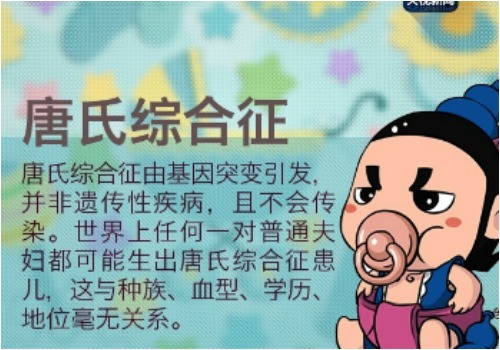
“I’m still nervously awaiting the results of the amniotic fluid test,” one netizen responds to the post: “I hope my baby is healthy and normal.”
On Chinese social media, many expecting mothers express their worries about screening results and the health of their unborn child. But the ethical debate that is so alive in many other countries about Down syndrome screening and abortion seems practically non-existent in China. One Weibo user comments: “In foreign countries, there are many mothers raising kids with Down, because their religion does not allow them to abort the baby.”
THE “LAST DOWNER”
“New medical techniques and the ethical questions that come with it have caused ample discussion on Down syndrome in many nations across the world.”
Down syndrome (DS) is a congenital disorder caused by a chromosome defect, that exists in all regions worldwide. Children with DS often have an intellectual disability and are also affected physically in their appearance and general health. Down syndrome has an incidence of 1 in 600–1000 live births, differing per country (UN; Wang et al 2013, 273). The disorder was named after John Langdon Down, the British physician who first classified this genetic disorder in 1862. In Chinese, it is known as 唐氏综合征 (Tángshì zònghézhēng) or as 先天愚型 (Xiāntiān yúxíng), the latter literally meaning ‘naturally stupid-type’.
With new techniques, it has become easier for doctors to safely detect whether or not a fetus has Down syndrome. In many countries, women can now choose for first-trimester prenatal screenings that can indicate the likelihood they are carrying a baby with Down syndrome. These tests can be followed up with diagnostic tests, either through amniocentesis (amniotic fluid test) or a DNA blood test, that can give a conclusive answer. If the unborn baby turns out to have DS, parents often have the option to abort it.
These new medical techniques and the ethical questions that come with them have caused ample discussions on Down syndrome in many nations across the world. Denmark introduced national guidelines for prenatal screening and diagnosis as early as 2004, which has led to an all-time low of Danish infants with Down syndrome – 95%-98% of pregnant women choose to abort a fetus with DS (Vice 2015). This means that Down could become something of the past; not just in Denmark, but also in other countries that have followed its example after 2004.
According to anti-abortion media, what is happening in Denmark is a “targeted form of genocide.” In the United States, the test has also become a focus of controversy, as it is intertwined with America’s general debate over abortion.
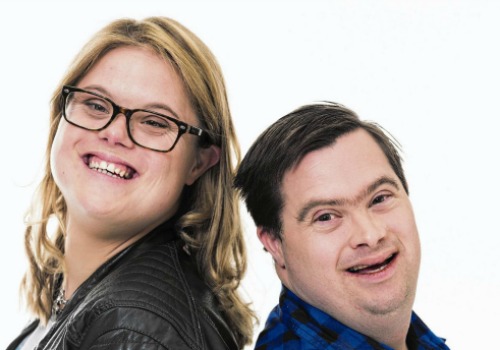
The Dutch TV-series “The Last Downer” (sic) explored the gradual disappearance of Down Syndrome. The show was co-hosted by two young adults who were born with DS themselves. Photo via NPO/NRC of TV Show “De Laatste Downer.”
In the Netherlands, a TV show revolving around ‘the end of Down syndrome’ was recently aired on national television. The series, that was titled ‘The Last Downer’, explored what society loses if Down syndrome disappears. It also talked about the ethical, social and psychological consequences of having a child with Down syndrome. ‘The Last Downer’ also triggered debate, as some critics deemed that it was too much in favor of the pro-life movement.
DOWN SYNDROME IN CHINA
“21% of abortions related to DS in China take place after the 28th week of pregnancy.”
In China, it is estimated that 1 out of 700 infants are affected with Down syndrome. Although this percentage is relatively low compared to other countries, it is an enormous figure nevertheless due to China’s huge population (Deng et al 2015, 311).
China’s Ministry of Health has promoted nationwide prenatal screenings for birth defects since 2003 (312). As pointed out in recent Chinese research, there has since been a sharp increase in the percentage of prenatal diagnosis and consequential birth termination (Deng et al 2015, 315).
The detection of Down syndrome through prenatal diagnosis in China went from nearly 13% in 2003 to over 69% in 2011 – with urban women having better access to early screenings and diagnosis than women living in the more rural areas of China. Around 95% of women terminate their pregnancy after learning the baby has DS, which is close to similarly high numbers in countries like Denmark or Hungary.
What is different in China, is that abortions can take place up to the ninth month of pregnancy.* In nearly 80% of the cases where the DS diagnosis led to abortion, this termination took place before 28 weeks. In the other cases, the pregnancy was terminated later than 28 weeks; meaning that 21% of abortions related to DS take place after the 28th week of pregnancy (ibid. 2015, 315).** In, for example, the Netherlands, abortion can take place up to 24 weeks of pregnancy, which is determined as the moment after which a fetus would be able to survive outside the uterus. Denmark allows for abortions to take place until the 12th week of pregnancy.
Chinese doctors encourage screening more strongly when pregnant women are older. According to current regulations in China, pregnant women aged 35 or above will be suggested to have an amniocentesis test directly, and, as research points out, “most Chinese women opt to abort fetuses with malformations” (Deng et al 2015, 316). Overall, the prevalence of prenatal diagnosis of DS and the number of related abortions is higher in urban areas than in China’s rural areas due to better medical facilities in cities. This also suggests that the majority of babies with DS are now born in the countryside, where parents do not always have access to the medical care they need.
ABORTION IS OKAY
“Bright-pink advertisements on ‘painless abortions’ depict smiling women, butterflies and flowers.”
On Weibo, many netizens share their experiences with prenatal screening. One pregnant woman says the test has cost her 191 RMB (±30 US$), another netizen responds: “In my hometown, these screenings are free of charge!” Another Weibo user shares her anxiousness: “I’ve been worrying about this Down screening all week,” she writes on April 21st. The following day, she replies to the comments with crying emoticons.
Although the screenings are a big issue on Chinese social media, the ethical question of the abortions is seemingly not. This might relate to the fact that abortion is not as contentious in China as it is in many other countries.
Pregnancy termination became quite common in China during the 20th century in relation to the one-child policy. By now, China has the highest abortion rate in the world. According to the National Health and Family Planning Commission, 13 million abortions are carried out in China every year. The actual number is probably much higher, as the official number does not include the abortion numbers from private clinics, nor the estimated 10 million induced abortions per year through medicine (Xinhua 2014), nor the numbers of sex-selective abortions– a practice that has officially been illegal since 2004.
The prevalence of abortions in China has led to a booming industry focused on abortion procedures. Bright-pink advertisements on ‘painless abortions’ depict smiling women, butterflies and flowers.
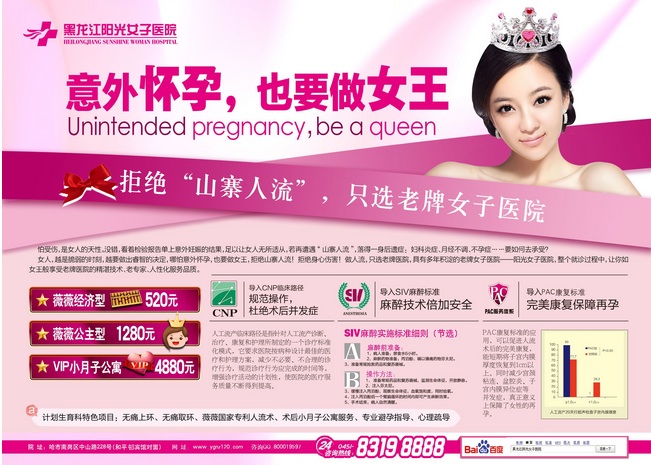
Some even promise that the abortion will be over within ‘a dreamlike three minutes’ (for more on this read: Glamorous & Painless – China’s Booming Abortion Industry). Although China has a painful past when it comes to forced abortions, the personal choice for abortion is not as controversial as it is in many countries where the Down syndrome detection debate is more alive.
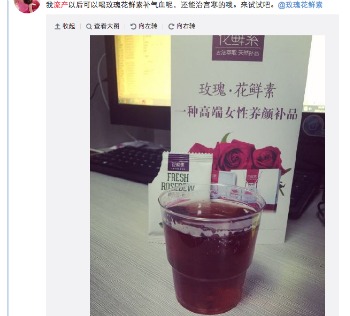
“I’m drinking fresh rosedew after my abortion,” one netizen writes: “It’s good for my cold womb.”
THE HARDSHIPS OF DOWN CHILDREN IN CHINA
“Giving a child with Down syndrome up for adoption is very difficult, as China’s DS children are generally deemed ‘unadoptable’.”
Besides the fact that abortion is considered relatively uncontroversial in China, the high rate of abortions for DS-diagnosed babies might also relate to the fact that disabled children face many difficulties in China due to stigmatization and practical hurdles.
Raising a handicapped child is a heavy burden for many parents in China, who receive little government support and often do not have the means to make sure their child gets the medical care and education they need. This means that abandoning the child sometimes is the only solution for parents to make sure their child is taken into an institution (Yoxall 2008, 25).
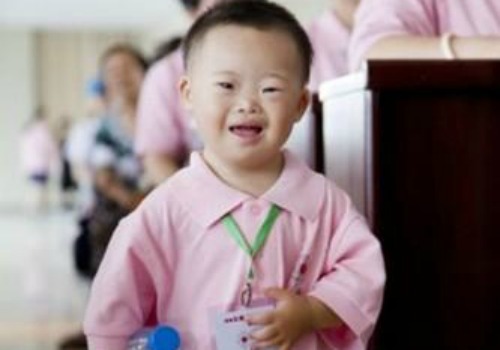
Giving a child with Down syndrome up for adoption is very difficult, as China’s DS children are generally deemed ‘unadoptable‘. Until recently, it was legally not possible to adopt a child with Down within China. Since this has now changed, international organizations like the Bamboo Project help parents who want to adopt a child with Down syndrome from China.
SCREENINGS FOR DOWN: ANXIETY & CONFUSION
“If your baby has Down syndrome, you can’t keep it – you do understand this, don’t you?”
In China’s urban areas, first-trimester screenings for DS (唐氏筛查) through a blood test have become practically mandatory. Some clinics have 100% screening guidelines for all of their patients, but do ask parents to sign for consent first; other hospitals simply proceed to include the test with general pregnancy check-ups without any permission.
Screening procedures differ per hospital and can be confusing for expecting mothers: “Today my doctor told me that because I am already 35, I should do an amniocentesis test,” one netizen writes on Weibo: “but the blood test in my first trimester indicated I had low risk of having a baby with Down. I’m very confused if I should do it or not.”
China’s screening procedures and prevalent attitudes on how to deal with a baby that possibly has DS can be shocking to some. A 31-year-old Dutch mum named Anna (alias), who lives in Shanghai, recently shared her experiences on Facebook. Anna, pregnant with her second baby, writes:
“I was unable to come on Facebook for some time due to problems with my VPN. During this period, I’ve come across something that I loathe even more than China’s internet censorship. “They’ve tried calling you but you didn’t pick up,” the Chinese nurse tells me while looking up from a form, as she points me to an examination room. I walk in, and ask the doctor what’s going on – I vaguely remember a ‘standard’ blood test (..) – “‘You have an increased risk for a child with a mental disability,’ the doctor straightforwardly tells me. ‘Excuse me?’ – I ask her to repeat her sentence. ‘The child might be retarded,’ she tells me.”
Anna writes: “In the Netherlands, the availability of prenatal tests for Down syndrome has caused quite some controversy earlier this year. It is not allowed for doctors to proactively encourage women to do this test unless there’s an increased risk for them to have a child with an intellectual disability – because they are above the age of 40, for example. But this is not the case in China, where every pregnant woman, no matter her age, is tested for heightened risk through blood screening. I ask the doctor what the test results are, since I’m only 31. ‘Well, that’s not like being 21 anymore, now it is?’ she snarls at me.”
Anna explains that the results of her blood test showed there was a 1-in-200 chance her baby had Down syndrome. After informing Anna about this, the doctor says: “You can choose if you now want an amniocentesis or a DNA test. The first is more expensive and needs to be done in a private clinic, here’s an information leaflet, just think about it.”
She chooses to do the DNA test, which is safer for mothers and their unborn babies than the amniocentesis. She says: “I was initially just shocked to hear there was an increased risk for me to have a child with a disorder, but it also bothered me that the initial screening was done without my consent. I ask the doctor what happens if my baby turns out to have Down syndrome. ‘Then you can’t keep it,’ she gives me a piercing look: ‘You do understand this, don’t you?’”
Anna writes: “She advised me to timely book a possible abortion, but that the procedure would be possible until 32 (!) weeks.” Anna receives the DNA test results a week later through text message, and her baby shows no signs of abnormalities. Despite her relief, she feels uncomfortable about the intrusive way in which her prenatal screening and its possible outcome was handled.
Another foreigner living in Beijing told What’s on Weibo they also were tested for Down syndrome risks in the first trimester of pregnancy at Beijing United hospital without being asked for permission first. Although they were surprised to get the results, they did not react strongly to it as the test turned out to be very low risk.
Although the ethical debate on this issue is generally lacking from mainstream media, one story did make headlines last year when a woman from Hubei was determined to end her pregnancy at 16 weeks because of the Down syndrome screening. The initial blood screenings showed an increased risk of DS, and the woman arranged an abortion – in spite of the doctors convincing her that she should wait for the actual diagnoses screening first. This story also shows how intertwined prenatal screenings and abortion have become.
DS IN CHINA: TABOOS AND SOCIAL STIGMA
“I think my sister’s baby has Down syndrome, but I am too afraid to ask her.”
Chinese netizens share their experience with Down syndrome on various online message boards. One netizen tells how it is growing up with a brother with Down syndrome. “My brother was born prematurely and was in weak health. The doctor told my parents to just give up on him. But my father refused to give up, because it was a boy, and he thinks boys are worth more than girls. So my brother lived.” The netizen tells how his parents were told by doctors that their child was simply “hopeless”, and that his brother was always teased in school.
On message board Douban, multiple netizens share how doctors encourage couples to have an abortion if their unborn baby is diagnosed with DS. The discussion of Down on Chinese social media shows that DS is heavily stigmatized and that it is sometimes also considered a taboo. Some netizens tell about former classmates with Down who were constantly bullied, and one netizen writes: “I think my sister’s baby has Down syndrome, but I am too afraid to ask her.”
Now that rapidly advancing medical techniques have decreased the prevalence of DS in China, chances are that the less common the disorder is, the more stigmatized it will become. It is also probable that over the next one or two decades, if rural areas get better access to medical care, Down syndrome will altogether disappear from China.

For China’s upcoming ‘day for the handicapped’, multiple organizations try to raise more public awareness for Down syndrome. This year, the day will specifically focus on handicapped orphans. For this occasion Chinese media recently wrote about an orphanage in Tianjin, where one-third of all children are Down syndrome babies who were left behind by their parents.
Although the article describes children with DS as little “happy angels”, one Chinese birth clinic seems to think otherwise. In their ad (see image), their message is loud and clear: “Reject children with Down syndrome! Give birth to a healthy baby!” Angels or not, modern-day China seems to have no place for Down syndrome children.
– By Manya Koetse
Follow @WhatsOnWeibo
[rp4wp]
References
Wang, S.-S., Wang, C., Qiao, F.-Y., Lv, J.-J. & Feng, L. 2013. “Polymorphisms in genes RFC-1/CBS as maternal risk factors for Down syndrome in China.” Arch Gyneocol Obstet 288: 273-277.
Deng, C., Yi, L., Mu, Y., Zhu, J., Qin, Y., Fan, X., Li, Q. & Dai, L. 2015. “Recent trends in the birth prevalence of Down syndrome in China: impact of prenatal diagnosis and subsequent terminations.” Prenatal Diagnosis, 35(4), 311–318.
Yoxal, James W. 2008. China’s Social Policy: Meeting the Needs of Orphaned and Disabled Children. Master Thesis, Union Institute & University.
NB: other references are linked to in-text.
* As written by Deng et al (2015): “Following a systemic and standardized diagnostic process, pregnancy affected by severe anomalies such as DS is allowed to be terminated at any gestational age following informed consent” (312).
** According to 2003-2011 surveillance data, study by Deng et al uses data from the Chinese Birth Defects Monitoring Network.
©2016 Whatsonweibo. All rights reserved. Do not reproduce our content without permission – you can contact us at info@whatsonweibo.com.
Manya is the founder and editor-in-chief of What's on Weibo, offering independent analysis of social trends, online media, and digital culture in China for over a decade. Subscribe to gain access to content, including the Weibo Watch newsletter, which provides deeper insights into the China trends that matter. More about Manya at manyakoetse.com or follow on X.

China Health & Science
Breaking the Taboo: China’s Sanitary Pad Controversy Sparks Demand for Change
After realizing domestic sanitary pads were literally falling short, Chinese netizens are demanding greater awareness and improvements in long-overlooked issues of quality, affordability, and societal attitudes toward menstruation.
Published
1 month agoon
December 6, 2024By
Ruixin Zhang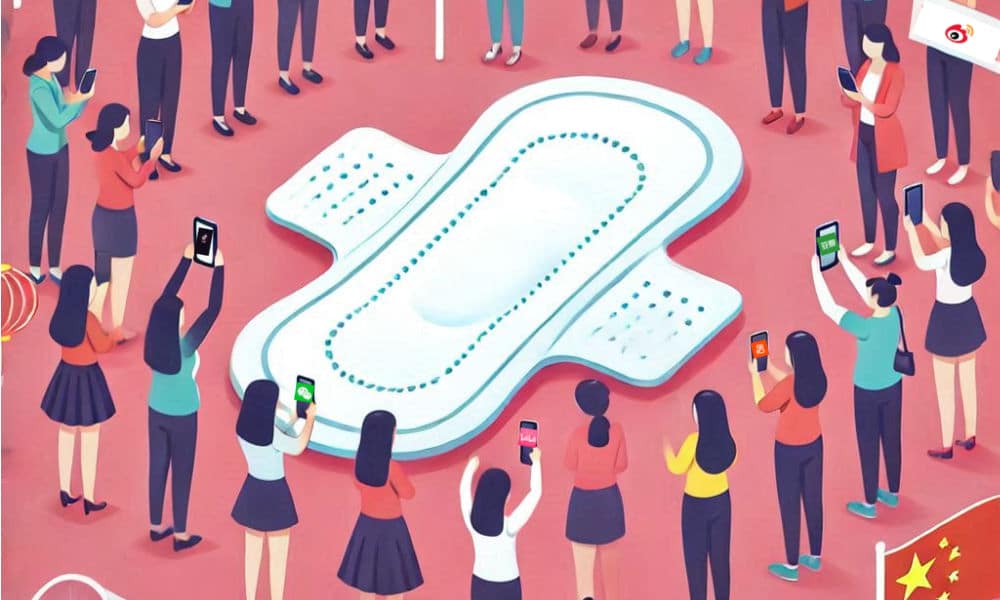
Sanitary pads have never been a bigger topic of debate on Chinese social media as it’s been over the past few weeks. What began with one blogger’s discovery of menstrual pads falling short of their advertised size has grown into a broader movement, demanding better-quality products and greater awareness of menstrual health.
Despite being a natural part of life for women around the world, menstruation remains a sensitive and taboo subject in many parts of China, particularly in more conservative, rural areas and smaller cities.
Essential feminine hygiene products like sanitary pads or tampons are often discreetly wrapped in dark plastic bags to avoid drawing attention.
However, this month, the silence was broken. “Sanitary pads” and related topics dominated online discussions, igniting a heated conversation that started with pad length but quickly expanded to include concerns about health, safety, and women’s rights.
EXPOSING THE “SHORTCOMINGS” IN SANITARY PADS
“Buy it if you want, or just don’t.”
In early November, a viral post on Xiaohongshu (later deleted) brought attention to a troubling issue. A woman who purchased sanitary pads online found them significantly shorter than advertised—a supposed 290mm pad measured only 250mm.
When she confronted the seller, they dismissed her concerns, citing a “normal 4% margin of error” and claiming, “If you order 290mm, we can only send 250mm—that’s the rule.”
The post struck a nerve. Netizens began measuring their own pads and discovered that many brands similarly fell short of their advertised lengths. This perceived deception ignited widespread outrage:
“They market themselves as designed for women, but even the lengths are misleading?”
“We pay the highest taxes for subpar products!”
The controversy soon spread to platforms like Douban and Weibo, where more and more people started comparing advertised versus actual pad lengths. The results revealed that many well-known brands consistently fell short, raising accusations of industry-wide cost-cutting.

Facing mounting pressure, several Chinese brands issued responses claiming their products adhered to the national standard that allows a ±4% length deviation. According to this standard, a 290mm pad can legally measure between 278mm and 302mm.
However, consumer measurements consistently showed pads at the lower limit—or even shorter. This raised suspicions that manufacturers were exploiting the -4% allowance as an industry norm to cut costs.
Some netizens compiled a crowdsourced chart comparing the advertised length, actual length, and cotton coverage of various brands. The findings revealed similar discrepancies across major brands.
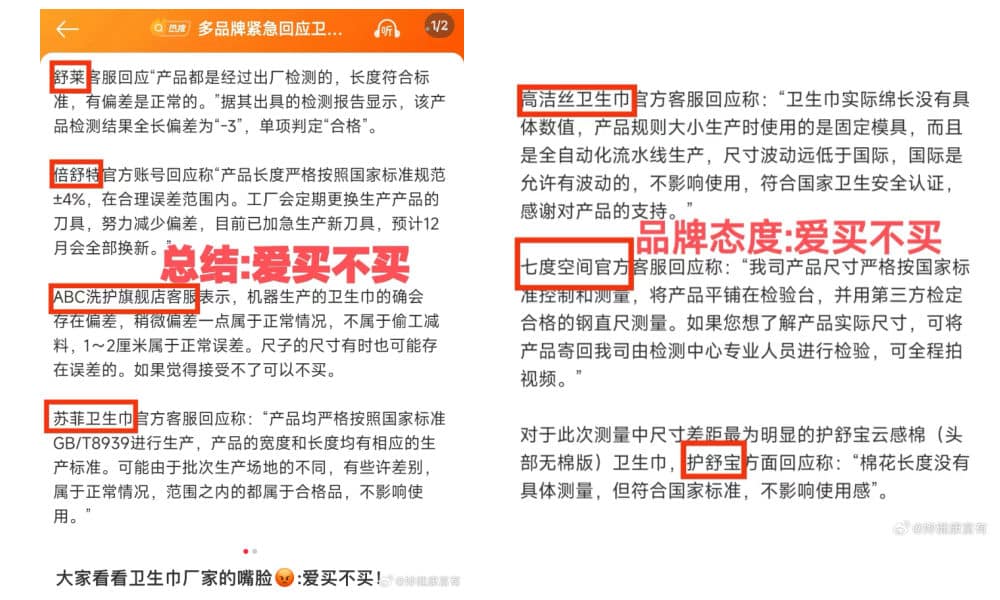
Various brands’ responses to the controversy listed by blogger @妳健康富有.
Some brands, with size deviations as large as -15%, responded evasively to consumer concerns, claiming that such deviations are normal and do not affect usage. These responses only fueled further frustration among netizens, who accused the brands of dismissing their concerns. As one blogger (@你健康富有) remarked, the brands’ attitude couldn’t be clearer: “‘Buy it if you want, or just don’t.'”
BEYOND LENGTH: A DEEPER ISSUE
“Society tolerates or even reinforces menstrual stigma.”
While the pad length scandal initially focused on cost-cutting, the ensuing discussions uncovered far more serious concerns. A resurfaced video by documentary filmmaker and blogger Fourfire (四火, @为了玲飞护肤纪录片) revealed the industry’s dark side. The video exposed illegal factories recycling used materials, including shredded pads and diapers, into new sanitary products. These contaminated pads, sold cheaply on e-commerce platforms, have been linked to pelvic inflammation and other gynecological problems.
In the video, Fourfire urged women to stick to well-known brands and purchase from reputable retailers.
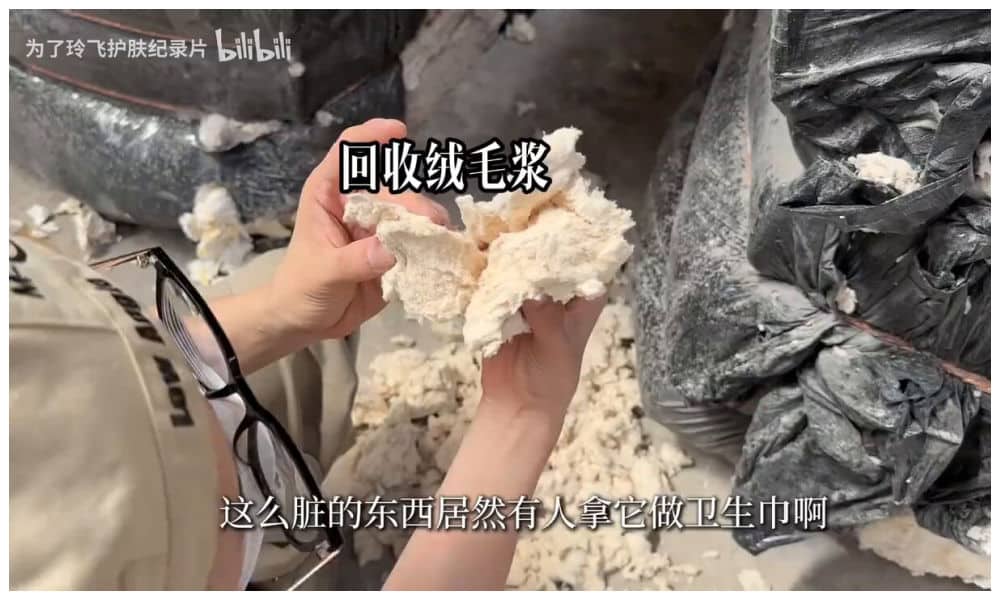
Still from the video by documentary filmmaker and blogger Fourfire (四火, @为了玲飞护肤纪录片)
But are pricier pads from major retailers truly safe? Quality issues with domestic brands have surfaced repeatedly, and this latest length discussion reignited those concerns. Consumer-created “red-flagged brands” for domestic pads feature numerous well-known brands with prior reports of containing maggots, mold, and other contaminants.
This renewed scrutiny prompted questions and discussions among female netizens. One user asked, “Is there any brand of sanitary pads that’s actually safe to use?” Among the hundreds of replies and shares, one prevailing sentiment emerged: “None of them.” Many users began to view previous quality issues not as isolated incidents but as indicative of broader problems within the industry.
Adding fuel to the fire, one blogger (@迷宝吃不饱) claimed that the national standards for sanitary pads in China allow a pH range of 4–9. This range aligns with standards for non-intimate textiles, such as jackets or curtains. Given that human skin is slightly acidic, with a pH between 4.1 and 5.8 (3.8–4.5 for intimate zones), products in close contact with the skin, such as sanitary pads, should ideally be designed to maintain the skin’s natural pH balance and prevent irritation.
This seemingly loose standard sparked further concerns among female consumers. Many began reflecting on their past experiences, sharing issues they’d faced while using sanitary pads—frequent inflammation, allergic reactions, itching, and other symptoms. Few had considered the possibility that these problems might be linked to the pads themselves.
In response, experts argued that the materials, hygiene, and sterilization of pads were far more critical than pH levels. However, in today’s China, where public trust in such authorities is relatively low (read: “Experts Are Advised Not to Advise“), this explanation not exactly reassured the public. Gynecologists and popular science influencers, such as Sixthfloor (@六层楼先生), pointed out that similar products like baby diapers and men’s sanitary pads are held to stricter production standards. This disparity naturally fueled suspicion and concern about women being disadvantaged and the role of societal taboos surrounding menstruation.
One Douban user commented: “Society tolerates or even reinforces menstrual stigma. The less we talk about sanitary pads, the easier it is for companies to profit from women.”
BREAKING THE SILENCE
“Decisions about menstrual products are being made by people who don’t menstruate.”
Sanitary pads in China are relatively expensive and not covered by health insurance. A single daytime pad from a common brand costs around 1 RMB ($0.15), while nighttime pads can be twice as expensive. Over a typical six-day period, a woman might spend 30-40 RMB ($4.15-$5.50) each month. Tampons, though less popular in China, are even more costly.
For women in impoverished or rural areas, this expense can be a significant burden. Many are forced to purchase low-cost, unregulated “three-no” products (no license, no standards, no brand), often manufactured by the shady companies exposed in Fourfire’s video. On Taobao, product reviews for these pads reveal heartbreaking stories. Some users recommend switching to safer, higher-quality options, but responses often reflect the harsh reality: “I don’t have a choice.”
Now, as major brands face public backlash, many women are turning to “medical-grade sanitary pads,” originally made for surgical recovery or heavy bleeding. According to the Sichuan Observation media channel (@四川观察), online searches for these products have jumped by over 3,000%. While safer, these pads are even more expensive.
The frustration is clear: “Do we really have to keep paying more for basic necessities just to protect our health? Why not just make regular sanitary pads safe and reliable? Is that too much to ask?”
So why is it so hard to produce affordable, safe sanitary pads without cost-cutting tricks? The answer may lie in a regulatory change made over a decade ago. In 2008, new national standards for sanitary pads eliminated quality grading classifications and reduced minimum requirements for the length of filling cotton. This gave manufacturers more freedom to cut costs, often at the expense of quality.
One glaring detail hasn’t gone unnoticed: the revised standards were drafted entirely by men. As one netizen commented, “Decisions about menstrual products are being made by people who don’t menstruate.” For women, the lack of female representation in an industry directly affecting them is both absurd and infuriating, highlighting a deeper issue of gender imbalance in industries and regulatory frameworks that shape women’s lives.
At the time of writing, distrust in domestic sanitary pad brands in China has reached a peak. Whether driven by exaggerated fears or valid concerns, one thing is clear: after years of menstrual stigma and neglect of women’s health issues, many women feel unheard and are now speaking out. This growing frustration has given rise to an online feminist movement, calling for accountability and demanding change from an industry—and a culture—that has long overlooked some of women’s basic rights.
GRASSROOTS EFFORTS FOR CHANGE
“Girls should never feel ashamed of their periods”
With policymakers mostly male, Chinese women have had to take matters into their own hands. Over the years, various incidents related to menstrual products have gone viral and triggered grassroots efforts to improve the status quo.
The last major public outcry about sanitary pads occurred in 2022 when a woman on a high-speed train discovered they weren’t available for purchase. She vented her frustration online, and the issue quickly gained traction. Many commenters, mostly men, argued that pads weren’t “essential items” and didn’t warrant taking up retail space onboard. The railway authority’s official response—categorizing sanitary pads as “personal items” that didn’t need to be sold—only intensified the outrage.
In the same year, a young woman in Covid quarantine in Xi’an went viral after she tearfully begged anti-epidemic staff for sanitary pads. When workers at her quarantine hotel told her there was nothing they could do, she asked, “So what? Does that mean I have to bleed a river of blood?”
For many women, these incidents highlighted how little society understands or respects their basic needs. In response, people organized online campaigns, flooded hotlines with complaints, and raised awareness about why menstrual products are essential. “Girls should never feel ashamed of their periods,” one netizen wrote.
Sometimes, progress is made. The woman in Xi’an’s quarantine later posted an update, saying she eventually received the menstrual pads she needed. And although pads are still not available on all high-speed trains, they are now provided on many routes—a small but meaningful step.
This time, the debate over pad quality has drawn even greater attention, involving public figures, celebrities, and even tech mogul and Xiaomi founder Lei Jun (雷军), with some hoping that a trusted brand like Xiaomi could play a role in making Chinese sanitary pads safer and more innovative. Women have launched cross-platform campaigns like #ShowYourSanitaryPads (#晒出你的卫生巾#), encouraging people to share posts on Weibo, Douban, and Xiaohongshu to call out brands for inaccurate sizing or poor quality.
Activists are also sharing step-by-step guides on filing formal complaints and advocating for stricter national production standards. The movement is gaining momentum, driven by a collective determination to demand safer, more reliable products.
On November 21, China News Weekly reported that a new national standard for sanitary pads is being drafted. CNR News also called for tighter industry oversight, signaling an urgent response to recent public criticism.
Yet, this response only scratches the surface of the deeper issues surrounding menstrual products in China. Challenges such as the high cost of pads, their limited availability in public spaces, and inadequate menstrual education persist. Will meaningful change continue to rely solely on grassroots efforts? Hopefully, this marks the beginning of a broader, systemic shift that not only addresses these immediate concerns but also redefines how society values and prioritizes women’s basic needs.
By Ruixin Zhang
Independently covering digital China for over a decade. Like what we do? Support us and get the story behind the hashtag by subscribing:
edited for clarity by Manya Koetse
Spotted a mistake or want to add something? Please let us know in comments below or email us. First-time commenters, please be patient – we will have to manually approve your comment before it appears.
©2024 Whatsonweibo. All rights reserved. Do not reproduce our content without permission – you can contact us at info@whatsonweibo.com.
China Health & Science
Stolen Bodies, Censored Headlines: Shanxi Aorui’s Human Bone Scandal
A Chinese company illegally acquired thousands of corpses to produce bone graft materials sold to hospitals—a major scandal now being tightly controlled on social media.
Published
5 months agoon
August 9, 2024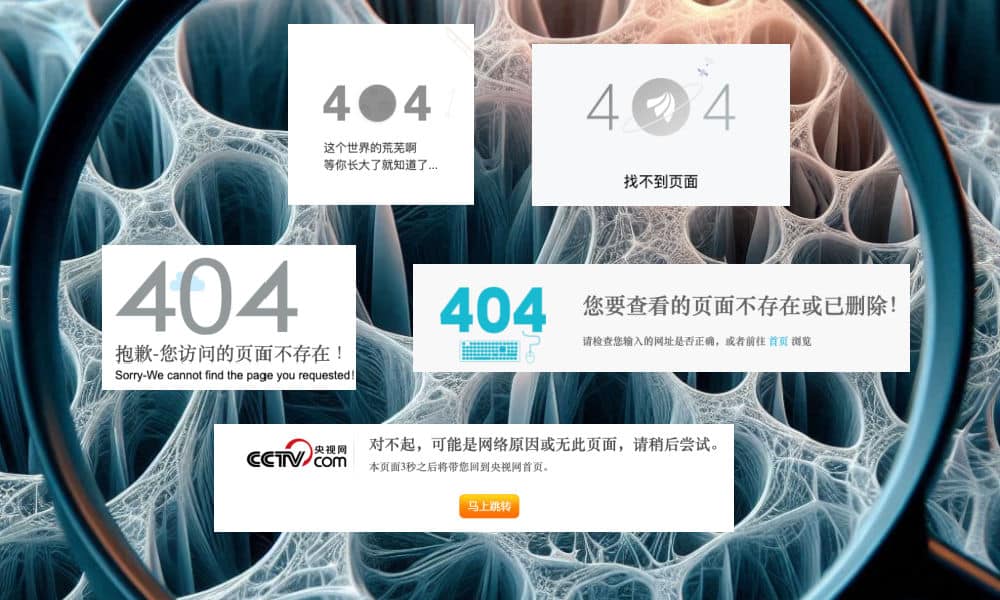
On Thursday night, August 8, while most trending topic lists on Weibo were all about the Olympics, a new and remarkable topic suddenly rose to the number one, namely that about the “Illegal Human Bone Case.” Just moments later, however, the topic had already disappeared from the Weibo hot search list.
An article about the topic by Chinese media outlet The Paper (澎湃)1 that had just been published hours earlier on August 8 had already been taken offline. Later, an article published on The Observer (观察)2 was also redirected. Another article published on the website of Caixin and state broadcaster CCTV similarly disappeared, 3 along with many other headlines.4
However, at the time of writing, there are some articles on the issue, such as by Sina News or Phoenix News, that remained accessible.
The story centers on Shanxi Aorui Bio-Materials Co., Ltd. (山西奥瑞生物材料有限公司), also known as Shanxi Osteorad in English, a company founded in 1999 that specializes in the production and supply of bone graft products.
On August 7, a prominent Chinese lawyer named Yi Shenghua (易胜华), who has a large following on Weibo, exposed details of Shanxi Aorui’s involvement in illegal and unethical practices surrounding the purchase of human bones. The company engaged in these practices for over eight years, from January 2015 to June 2023, generating an income of 380 million yuan ($53 million) from these activities.
These details had previously been disclosed by the Taiyuan Public Security Bureau in May of this year. The case has allegedly been transferred to the Taiyuan Procuratorate for review and potential prosecution, but it has yet to be concluded due to its complexity, involving some 75 suspects.
Over the years, Shanxi Aorui illegally acquired thousands of human remains, reportedly forging body donation registration forms and other documents to illegally purchase bodies from hospitals, funeral homes, and crematoriums from various places, from Sichuan Guangxi, Shandong, and other places. These human remains were then used to produce allogeneic bone implant materials, primarily sold to hospitals.
Due to the high demand for bone implant materials and limited supply, it is an incredibly lucrative industry. Some reports claim that those selling the human remains to Shanxi Aorui could charge between 10,000 and 22,000 yuan per corpse ($1400-$3000).
“I’ve been a criminal lawyer for many years, and have handled all kinds of cases, but this is the first time for me to be so shocked and angry,” Yi Shenghua wrote in his post (screenshot available via RFA.org).”What makes me particularly lose hope is that the maximum punishment for these kinds of people under the current law is only three years.”
However, Yi Shenghua’s Weibo post about the issue was later blocked from public view. “I can still see my own post, but apparently, others cannot,” Yi wrote at 17:35 on Thursday.
On August 9, China’s major pharmaceutical company Sinopharm issued a statement in light of the controversy surrounding the human bone case, stating it has never had any kind of relationship with the Shanxi Aorui company.
On Friday, the news topic on Chinese social media was tightly controlled. Various media outlets, from Weibo to Douyin, reported on the issue, but despite the public’s interest in the scandal, not a single comment could be seen under multiple threads.
‘Even Douyin blocked the Shanxi Aorui incident. Is this the government stepping in?’ one commenter wondered.
‘Why are they suppressing this hot search topic? Do they think the public is stupid?’ another person wrote.
One individual implicated in this case is Li Baoxing (李宝兴, born 1955), who was General Manager at Shanxi Aorui. Li is a renowned research professor who was reportedly awarded the title of National Model Worker in 2005. He was formerly affiliated with the Institute of Biomaterials Science and Technology at the Chinese Academy of Sciences, where he developed bone implant materials that benefited thousands of patients across the country. He allegedly joined the Communist Party in 1985.
Some commenters called the entire scandal a “horror film,” with Li Baoxing being the director.
“We know about 4000 [human remains], what about those we don’t know about?”
“These so-called ‘human remains’ were once people like you and me,” another Weibo user wrote: “They were alive, their voices and smile are still in the hearts of family and friends. They liked to be clean, they had their privacy, they are still being missed. We can’t replace ourselves or our loved ones, [yet] they were used and peeled layer by layer.”
By Manya Koetse
1 Title: “探访涉盗卖数千具人体骨骼的山西奥瑞公司,此前已被公安查封” (“Investigation into Shanxi Aorui Bio, involved in the illegal sale of thousands of human bones, which had previously been seized by police”). Original link: https://www.thepaper.cn/newsDetail_forward_28348324
2 Title: “涉嫌非法盗卖数千具遗体用于制作植入材料,山西奥瑞生物八年营收3.8亿” (“Suspected of illegally stealing and selling thousands of human remains for use in making implant materials, Shanxi Aorui Bio made an eight-year revenue of 380 million yuan”). Original link: https://www.guancha.cn/GongSi/2024_08_08_744234.shtml
3 CCTV’s publication is the same as the article published by The Paper, namely: “探访涉盗卖数千具人体骨骼的山西奥瑞公司,此前已被公安查封” (“Investigation into Shanxi Aorui Bio, involved in the illegal sale of thousands of human bones, which had previously been seized by police”). Original link: https://news.cctv.com/2024/08/08/ARTIkxoJEQuHmvTxmxGVmDug240808.shtml. Caixin’s publication was titled “75人卷入山西盗窃倒卖遗体案 多地民政局称已跟进调查” (75 people involved in the theft and sale of human remains in Shanxi, investigations underway by various civil affairs bureaus).
4 For example, by Sina News: “起底倒卖4000具尸体操控者李宝兴- 曾获“全国劳模”称号” (“Li Baoxing, the manipulator who speculated in 4,000 corpses, was awarded the title of “national labor model”). Original link: https://finance.sina.com.cn/chanjing/gsnews/2024-08-08/doc-inchxqva1690315.shtml?cre=sinapc&mod=g.
Spotted a mistake or want to add something? Please let us know in comments below or email us. First-time commenters, please be patient – we will have to manually approve your comment before it appears.
©2024 Whatsonweibo. All rights reserved. Do not reproduce our content without permission – you can contact us at info@whatsonweibo.com.
Subscribe

Introducing What’s on Weibo Chapters

Weibo Watch: A New Chapter

Our Picks: Top 10 Chinese Buzzwords and Phrases of 2024 Explained

Weibo Watch: Christmas in China Is Everywhere and Nowhere

12-Year-Old Girl from Shandong Gets Infected with HPV: Viral Case Exposes Failures in Protecting Minors

The Price of Writing Smut: Inside China’s Crackdown on Erotic Fiction

The Hashtagification of Chinese Propaganda

Controversial Wanghong Livestreamers Are Becoming a Weibo Staple in China

Weibo Watch: “Comrade Trump Returns to the Palace”

The ‘Cycling to Kaifeng’ Trend: How It Started, How It’s Going

Hu Xijin’s Comeback to Weibo

The Viral Bao’an: How a Xiaoxitian Security Guard Became Famous Over a Pay Raise

Our Picks: Top 10 Chinese Buzzwords and Phrases of 2024 Explained

Why Chinese Hit Movie “Her Story” is ‘Good Stuff’: Stirring Controversy and Celebrating Female Perspectives

Chiung Yao’s Suicide Farewell Letter: An English Translation
Get in touch
Would you like to become a contributor, or do you have any tips or suggestions? Get in touch here!
Popular Reads
-

 China Insight8 months ago
China Insight8 months agoThe Tragic Story of “Fat Cat”: How a Chinese Gamer’s Suicide Went Viral
-

 China Music10 months ago
China Music10 months agoThe Chinese Viral TikTok Song Explained (No, It’s Not About Samsung)
-

 China Insight11 months ago
China Insight11 months agoThe ‘Two Sessions’ Suggestions: Six Proposals Raising Online Discussions
-

 China Digital7 months ago
China Digital7 months agoChina’s 2024 Gaokao Triggers Online Discussions on AI


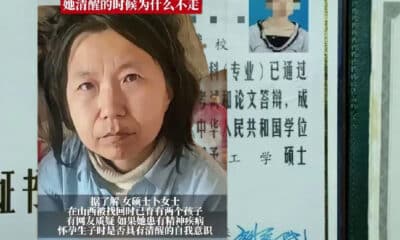




Colette
July 18, 2016 at 1:02 am
In the UK termination for DS is also permitted until 9 months………Lord Shinkwin is trying to change this.
jack
October 27, 2016 at 3:40 am
The truth is the chinese and the Japanese are a mongoloid race they were created from the daughters of a man called Lot the nephew of abraham in the bible read the story of Sodom and gomorrah this will tell of Lots two daughters and there plan…the modern day chinese are the moabites and the Japanese are the modern day ammonites,incest causes down syndrome or retardation these two nations are the product of incest…BASTARD babies…truth is hard to accept
Anonymous
December 27, 2016 at 6:11 am
Please go back to /pol/.